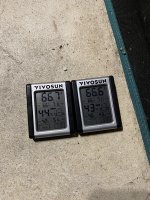Safe Gardener
Active member
I’ll turn then down at lights on this evening. I’m going say a little from column A and a little from column B as far as plant/root health at transplant. It was root bound to some degree but grew really well for a few weeks before I put it in flower.Either or both, as it will reduce the light intensity.
Were the plants growing healthy after your final transplant, before you put them into flower? (or in early flower) ? if not then that may have compromised them a bit. as would being completely rootbound before you transplanted them.
VG




